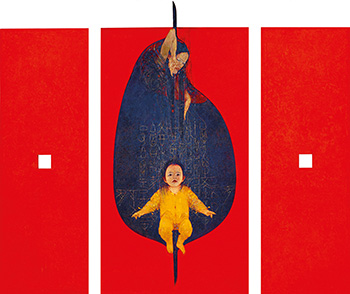EXHIBITED:
Michell Hwang Solo Exhibition, Lung Men Art Gallery; Vien Gallery, Taipei, April 26-May 7, 1986
ILLUSTRATED:
Michell Hwang Solo Exhibition, Lung Men Art Gallery; Vien Gallery, Taipei, 1986, color illustrated, exhibition invitation card
Michell Hwang 1992, Galerie Pierre, Taichung, October 1992, color illustrated, no. 5, p. 29
Michell Hwang 1994 Faces of the Modern City, Galerie Pierre, Taichung, August 1994, black and white illustrated, pp. 6-7
Catalogue Note:
In this work, entitled “Continuation”, a beautiful woman with slender fingertips tilts a head of disheveled hair towards the innocent child at the front of the painting. The child seems to gaze into an enigmatic future, with bright, clear eyes. Michell Hwang, who previously seldom talked about his past, explains that the women, children and family members in his paintings are usually fictional, while the figures in “Continuation” actually are his ex-wife and child.
“Continuation”, a triptych on a large-scale commonly seen in altarpieces, impresses viewers with its cultural trappings of centuries-old traditions such as intense red color and Chinese characters derived from oracle bones. Hwang made holes on the canvas and extended his painting with real objects in “Continuation”, breaking artistic boundaries in Taiwan at the time while demonstrating graphic art by way of installation art. These avant-garde techniques were already familiar to Hwang at the time and he uses these expressive techniques to capture his emotions while showing the direction for his later artistic creations.
An image of this auction item, “Continuation”, was used for the invitation cards of Hwang’s first Taipei exhibition five years after he came back from the U. K. “After a series of young ladies, babies, and old men as well as self-analytic exploration of symbolic styles, Hwang’s life experienced ups and downs and he noticed that graphic art could not satisfy the needs of contemporary art. Thus he attempted to integrate paintings and real objects. He neither denied the original completeness of paintings nor fully embraced “Dadaism”. Between planar and three-dimensional design, abstract ideas and real objects, and representation and expression, Hwang never stops trying to test his limits through his passion for life and obsession with art. This may stem from his inner desire to surpass painting and ordinary decoration….It can further expand the territory of expression and inspire a mystical response in viewers, whether real or surreal, creating a whole new balance and impact on the senses.” (Huang Chyi-wen, Invitation Card of Michell Hwang’s Exhibition, 1986)
The cocoon shape and the decorative dancing color strokes surrounding the female face brings to mind Gustav Klimt’s paintings. Gustav Klimt was obsessed with beauty and so is Hwang. Hwang always dresses in strong personal style showing his innegligible existence. Just like his paintings and sculptures, he looks majestic while he is actually a sincere and sensitive person. Professor Wang Che-hsiung once said, “Huang chooses his objects on a mundane level. That is, instead of things far away and long ago, he chooses things he can see, hear and sense in real life such as family relationships and romantic love. However, the techniques he employs to present these worldly objects are metaphorical, fable-like or symbolic. In brief, most of Hwang’s paintings comprise a symbolic and metaphorical autobiography.”
From 1985 to 1990, Hwang underwent a period of transformation that led to his flamboyant abstract expressionist paintings. After 1995, he become more and more interested in working on three-dimensional pieces, making the images of his paintings burst from the frame. After each period of transformation Huang reappears with an emboldened spirit. “Continuation”, a rarely-seen work from his early period created in 1982, can be viewed as a landmark in the establishment of his symbolic language as well as a classic work revealing his talent and endeavor.
Close friends of Hwang’s know that he has relocated his studio several times because he believes that an artist should have a completely suitable studio to meditate, create, and live in. Hwang’s studio is now located in his hometown of Luodong, Yilan. When he was young, he left his hometown and invested his inheritance in pursuing his dreams. Now, after decades of endeavors, he has come back bringing honor to his hometown with his achievements in the arts. His wide and high-ceiling studio serves as a palace of art where he can freely create his large-scale works as he likes. The life of an artist is full of romance and beauty. Furniture such as a fan by the wall and a heater are turned into unique art works after Hwang’s alteration. The autumn sun illuminates the white studio while a bottle of wine is always on hand for friends who drop by for a chat. Growing along the fence are roses of various colors, waiting for someone to pick them. In his studio, Hwang bashfully smiles, sips some red wine, and then talks about his future plans. With his eyes shining brightly, this pioneer of the arts is getting ready to cause another sensation.
